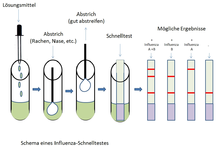Influenza rapid test
The rapid influenza test is used for the rapid, indicative diagnosis of influenza when more sensitive methods are not available.
When treating influenza with drugs from the neuraminidase inhibitor class (e.g. zanamivir and oseltamivir ), the therapy of which should begin within 48 hours of the onset of the first symptoms of the disease, it is necessary to make a reliable diagnosis at short notice. Laboratory-based diagnostics would take too long, so the use of an influenza rapid test would be an option here. Furthermore, it is necessary to differentiate influenza (A and B) from the approx. 200 viruses that cause acute respiratory diseases (ARE) . Resistance is not recorded.
Influenza rapid tests are based on the detection of influenza antigens that are in the sample material. The influenza antigens are detected by conjugated antibodies that are in a test strip. The test strip is composed of a nitrocellulose - membrane constructed. To carry out the test, one side of the test strip is dipped into the sample material and the liquid is passed over the test strip by capillary action . If antigens are present, antigen-antibody complexes are formed, which are then visible as colored markings. This method is similar to the immunoassay . Nasal rinsing fluid and nasal / throat swabs are used as sample material . The test only takes 15 minutes.
The rapid tests achieve a sensitivity of approx. 80% and a specificity of approx. 85%; this means an incorrect result (false positive or false negative) in about 15–20% of the examinations. Regardless of the sensitivity, positive findings obtained by means of the rapid test must be reported when the findings are communicated. These values depend on the environmental conditions. Food intake shortly before the rapid test can be e.g. B. with a throat swab lead to negative results, as the number of viruses in the throat is then reduced. Influenza rapid tests are not reimbursed by the GKV (statutory health insurance). A positive rapid test result should be confirmed in a diagnostic laboratory using PCR .
literature
- H. Uphoff, C. Metzger: On the use of rapid influenza tests for individual diagnosis. In: DMW - German Medical Weekly. 127, p. 1096, doi : 10.1055 / s-2002-30134 .
